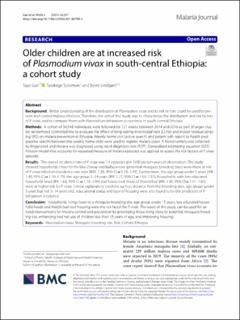| dc.description.abstract | Background
Better understanding of the distribution of Plasmodium vivax and its risk factors could be used to prevent and control malaria infection. Therefore, the aim of this study was to characterize the distribution and risk factors of P. vivax, and to compare them with Plasmodium falciparum occurrence in south-central Ethiopia.
Methods
A cohort of 34,548 individuals were followed for 121 weeks between 2014 and 2016 as part of larger cluster randomized controlled trial to evaluate the effect of long-lasting insecticidal nets (LLINs) and indoor residual spraying (IRS) on malaria prevention in Ethiopia. Weekly home visit (active search) and patient self- report to health post (passive search) between the weekly home visits were used to register malaria cases. A blood sample was collected by finger prick and malaria was diagnosed using rapid diagnostic test (RDT). Generalized estimating equation (GEE) Poisson model that accounts for repeated measure of malaria episodes was applied to assess the risk factors of P. vivax episode.
Results
The overall incidence rate of P. vivax was 7.4 episodes per 1000 person-years of observation. The study showed households closer to the lake Zeway and Bulbula river (potential mosquito breeding sites) were more at risk of P. vivax infection (incidence rate ratio (IRR): 1.33; 95% CI = 1.23–1.45). Furthermore, the age group under 5 years (IRR: 1.40, 95% CI = 1.10–1.79), the age group 5–14 years (IRR: 1.27, 95% CI = 1.03–1.57), households with less educated household head (IRR: 1.63, 95% CI = 1.10–2.44) and house roof made of thatch/leaf (IRR: 1.35, 95% CI = 1.11–1.65) were at higher risk for P. vivax. Similar explanatory variables such as distance from the breeding sites, age group (under 5 years but not 5–14 years old), educational status and type of housing were also found to be the predictors of P. falciparum incidence.
Conclusion
Households living closer to a mosquito breeding site, age group under 15 years, less educated household heads and thatch/leaf roof housing were the risk factor for P. vivax. The result of this study can be used for tailored interventions for malaria control and prevention by prioritizing those living close to potential mosquito breeding site, enhancing bed net use of children less than 15 years of age, and improving housing. | en_US |

